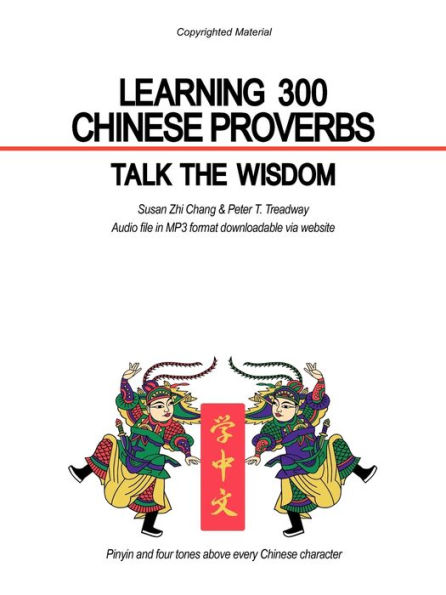
Learning 300 Chinese Proverbs: Talk the Wisdom
356
Learning 300 Chinese Proverbs: Talk the Wisdom
356Paperback
-
PICK UP IN STORECheck Availability at Nearby Stores
Available within 2 business hours
Related collections and offers
Overview

Product Details
| ISBN-13: | 9781426963032 |
|---|---|
| Publisher: | Trafford Publishing |
| Publication date: | 11/18/2011 |
| Pages: | 356 |
| Product dimensions: | 8.25(w) x 11.00(h) x 0.74(d) |
| Language: | Chinese |
Read an Excerpt
LEARNING 300 CHINESE PROVERBS
TALK THE WISDOMBy Susan Zhi Chang Peter T. Treadway
Trafford Publishing
Copyright © 2011 Susan Zhi Chang and Peter T. TreadwayAll right reserved.
ISBN: 978-1-4269-6303-2
Preface
This is a book of Chinese proverbs. We think it is very unique. It is first and foremost a tool for learning spoken and written Mandarin Chinese, complete with sections on grammar and an innovative approach to learning pronunciation. In that sense, it is a very practical book, useful to the beginner and advanced student alike. Every proverb represents a new lesson. Students can choose whatever proverb interests them at a given moment.The book may be of use not only to English-speaking students of Chinese but also to native Chinese speakers who want to learn more about English as well as their own language. The book uses Simplified Chinese and the Pinyin transliteration system for rendering Chinese characters into English. Both of these are the standards used in Mainland China. China has many spoken dialects, but the pronunciation followed in these books is that of standard Mandarin.
The book is much more than a Chinese textbook. China has a civilization and language that go back thousands of years. Buddhism, Confucianism, Legalism, Daoism, an awareness of history, a sinocentric worldview, and yes, male chauvinism—all permeate the Chinese language. Chinese proverbs are, in a sense, the DNA of Chinese culture and language, blueprints preserving the past and advising the present. Speakers of Chinese know what these proverbs are saying, but Westerners need a guide. The meanings of many of the proverbs are not obvious to Westerners. For example, when Chinese say the proverb "Dog chases mouse," they mean "Mind your own business." (Dogs don't chase mice; it's not their job.) It is no wonder that English-speaking people can find Chinese difficult. The thought process is different.
The book is the product of two people working together, one a native Chinese artist (Susan) who has lived in the United States since 1981 and the other an American writer, money manager, and economist (Peter) who has lived in Asia for many years and who does not speak or write Chinese. The book is the product of two people of different backgrounds interchanging and mixing ideas, of two people actually fighting and screaming at one another until we got it right! Writing the book was great fun—and sheer torture.
Susan compiled the proverbs and did the initial translations. It was Peter's job to write a Comment for the proverbs and to put them all into flowing, not- always-literal, grammatically correct English. We did not want fortune cookie translations.
Susan also did the delightful sketches that can be found with many of the proverbs. One picture is worth a thousand words, and readers can immerse themselves in the Chinese atmosphere.
A proverb in Chinese must have more than four characters. If a saying has only four characters, it is an "idiom." This book is about proverbs only.
Also a note on gender: For the English translations and Comments, we have elected to use the traditional masculine "he" and "his" rather than the logical but clumsy "he or she" and "his or her" or the politically correct "she" and "her." This seemed more convenient since, although Chinese generally does not specify a gender at all, frequently the reference is in fact masculine. We hope the reader will understand this choice.
Finally, recordings of all the proverbs in Mandarin Chinese in MP3 format can be downloaded from www.susanchang.com/300audio.
(Continues...)
Excerpted from LEARNING 300 CHINESE PROVERBS by Susan Zhi Chang Peter T. Treadway Copyright © 2011 by Susan Zhi Chang and Peter T. Treadway. Excerpted by permission of Trafford Publishing. All rights reserved. No part of this excerpt may be reproduced or reprinted without permission in writing from the publisher.
Excerpts are provided by Dial-A-Book Inc. solely for the personal use of visitors to this web site.
